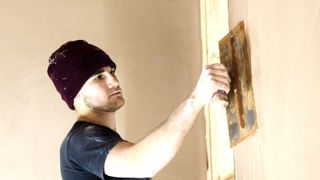How long does plaster take to dry? The answer might not be as straightforward as you think
How long does plaster take to dry? It’s a simple question but it doesn’t have a simple answer. Discover drying and curing times for the popular types of plaster

If you’ve got newly plastered walls you need to know how long does plaster take to dry? Knowing the drying and curing times of different plasters is essential so you can plan ahead and not jump into a project too soon.
Whenplastering wallsthe plaster itself sets in a couple of hours so it stays on the wall and ceiling. But it doesn’t fully dry, which it needs to do before you start whatever project you have in mind. If you don't and you decide to paint, wallpaper or start drilling into the plaster you could encounter some unwanted problems.
For example, if you start painting a wall before the plaster is fully dry you are going to get a poor finish. Moisture will be trapped in the plaster which will cause the paint to start flaking, or even worse mould to start growing.
Here, we explore the drying times of different types of plaster.
How long does plaster take to dry? The difference between drying and curing times
The answer to 'how long does plaster take to dry?' can be quite confusing. The assumption is that drying times refer to the time it takes before you can start working with the plaster. This is where the confusion exists.
Drying times refer to how long the plaster will take to set. These times are much quicker than the time needed for the plaster to fully dry — known as curing.
Plaster might take a couple of hours to set, but much longer to cure. For example, if you arepainting new plasteryou will have to wait for around a week before you can start painting.
But, surrounding environmental factors determine actual drying times. If the plaster is in a well-ventilated area and the weather is warm, the plaster will dry much quicker than an area where there is little ventilation or warmth.
A quick guide to drying and curing times for new plaster
There are a lot of different plasters around, but typical setting times are between one and three hours. The curing times for most common plasters found in the home is between four to six days, but some specialist plasters can take up to one month.
Here’s a quick guide to drying and curing times for new plaster:
Undercoat plaster
This is the basecoat that's typically applied to block or brick work to prepare walls, and to ceilings too, for the finishing plaster. These include bonding plaster, browning plaster and hardwall plaster.
- Drying time: one to five hours
- Curing time: four to 14 days
Finishing plaster
This is used to provide the final smooth and durable plaster that you see when you look at a newly plastered wall. It is often a pinky brown colour — and turns a light pinkish colour when cured.
- Drying time: 1.5 to four hours
- Curing time: 3-10 days
However, if you are skimming plasterboard the curing time will be much quicker.
Specialist plaster
Lime plasterwas traditionally used in older homes to cover the surface of internal walls and ceilings.
- Drying time: four to 10 days
- Curing time: two weeks to one month
If plaster gets minor damage you need to knowhow to patch plaster. This is often done withpatching plasterand is typically used for small areas where plaster needs repairing rather than covering whole walls. This dries very quickly, especially when used in small quantities.
- 干燥时间:一至四个小时
- Curing time: one to two days
How can you tell when plaster is dry?
One simple solution is to leave the plaster for a week in a well-ventilated room. But it could dry out sooner as Gary Blackburn, Plaster Support Manager at Saint Goabian points out: “The drying time of plaster varies mainly due to external factors such as the temperature and the humidity. It is usually dry anytime between two and four days and wherever possible plaster should be allowed to dry out naturally.”
To make sure a visual check is a good indicator of when it is dry: “When plaster sets it turns to a mid-brown colour turning to a light salmon colour as it dries,” says Gary.
Does heat help plaster dry?
Yes and no — a low level heat and good ventilation will help speed up the drying process. But if you can, you are better leaving windows and doors open to help the air flow through a newly plastered room.
You can turn up your heating indoors if the temperature in a room doesn’t match up to the recommended drying temperature. For example, if the optimum drying temperature is 25 degrees then match up the heating with this.
引入一个加热器或出现加热high can cause the plaster to dry out too quickly, which in turn can cause it to crack.
Can I sleep in a room that has just been plastered?
Newly plastered walls don’t let off any harmful fumes, but they do contain a lot of moisture. This makes a room feel damp, so realistically you don't want to be moving back into a room that has been plastered for at least a couple of days. This will have given the plaster a little time to dry out.
But if you are painting orwallpapering new plasterthe room then you are better off waiting until the plaster is completely dry. It is the perfect opportunity to paint and/or wallpaper as you will have an empty room to work in. Once you have finished painting and decorating the room you won’t have to think about moving furniture for a good few years, when you need to redecorate.
Get the Homebuilding & Renovating Newsletter
Bring your dream home to life with expert advice, how-to guides and design inspiration, direct to your inbox.
Steve is Homebuilding & Renovating's DIY content editor, and has been a writer and editor for two decades. He is an avid DIYer with over 20 years of experience in transforming and renovating homes. He specialises in painting and decorating, but has strong all-round building skills, having previously worked in the industry for 10 years.
Most Popular
Bring your dream home to life with expert advice, how-to guides and design inspiration, direct to your inbox.
Thank you for signing up to Homebuilding. You will receive a verification email shortly.
There was a problem. Please refresh the page and try again.

